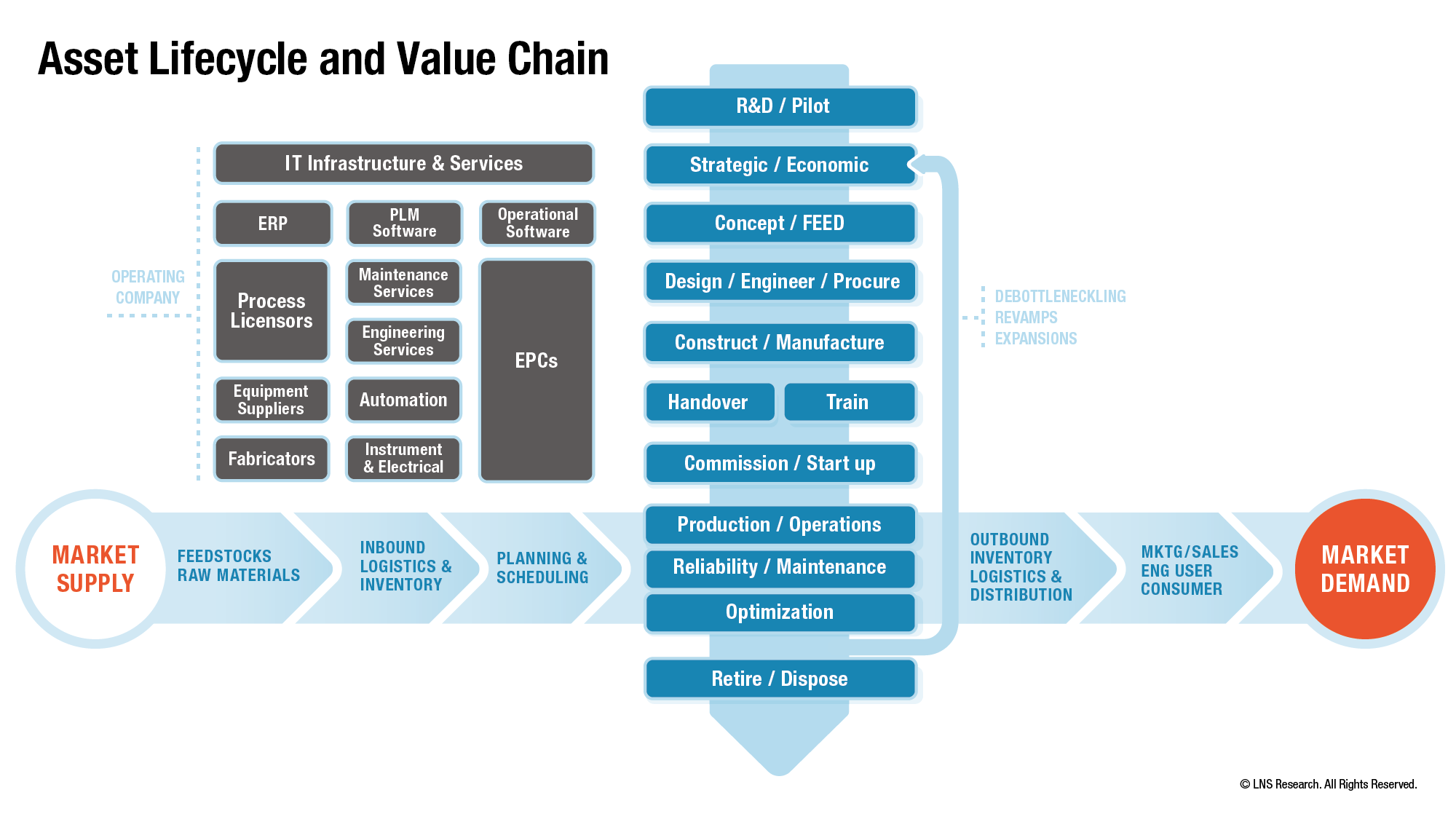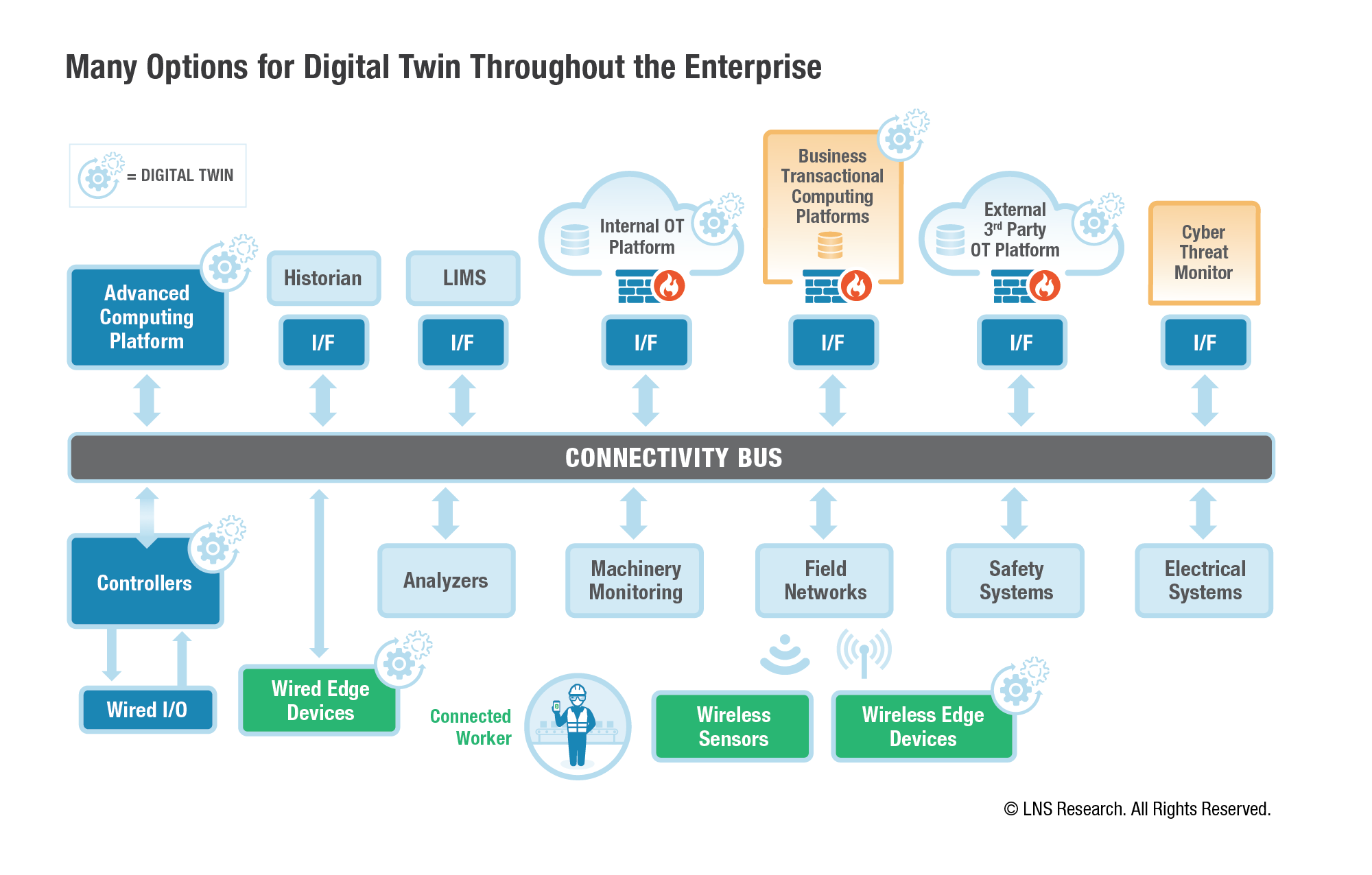Understanding the vendor landscape is essential for both industrial organizations as well as solution providers that seek to understand competitors, and the process Digital Twin market is no exception. There is a broad spectrum of Digital Twin vendors across the industry, but basically, they fall into a handful of supplier categories:
- Independent software vendors (ISVs)
- Automation
- Startups
- Enterprise
- Big tech
- Manufacturers
There is also significant partnering activity among the broad Digital Twin group as suppliers look to fill in solutions along both axes ― asset lifecycle and value chain.

We can also categorize suppliers by the type of twins they offer such as design and engineering, process, or asset reliability and integrity; there are also those that offer analytics platforms and products from which industrial organizations can build twins.
ISVs include software suppliers like AspenTech and AVEVA that offer a broad range of solutions that touch nearly all aspects of the asset lifecycle and value chain. With so much to tell and so much ground to cover, a challenge for these vendors is assembling the right value propositions. ISVs also include the design and engineering firms like Bentley and Dassault, which have partnered to connect their 3D models with the rest of the asset lifecycle.
The majority of automation vendors offer reliability and integrity twins. Some are also in the process twin space, e.g. Honeywell and Yokagowa via KBC, and the electrical twin space, e.g., ABB, Siemens, and Schneider along with GE Digital. All offer control and safety system twins to support pre-commissioning and operator training systems (OTS). The trend is to use a commercial process twin as the core of the OTS. The automation vendors along with the ISVs have made considerable progress with asset twins, but a challenge remains as to how they relate to process and other twins.
Startups have mainly surfaced in the asset twin space in the midstream and downstream, primarily centered around rotating equipment, but are quite common in the upstream. A number of oil majors and independents have implemented twins for drilling rigs, reservoirs, and completions using these startups, funded by venture capital including funds from the oil companies themselves. What remains to be seen is how this upstream market shakes out, since only a few startups reach critical mass; others are acquired perhaps by the oilfield service providers, and the majority will likely fade away.
The enterprise vendors such as SAP, Oracle, Infor, and IFS have long had enterprise asset management (EAM) solutions which they have now extended with asset twins. All have added advanced analytics capabilities and in some cases IoT platforms with Edge capability. Their challenge is a lack of deep industry operational knowledge and understanding of the physics side. This gap will limit them in asset twins and will be a significant barrier to implementing the other twins valued by operating companies.
Big tech like IBM, Amazon, and Microsoft too will face the same challenges as the enterprise vendors in that they lack the operational and physics know-how. IBM has strength in asset performance management (APM) with Maximo, but Watson doesn't offer process industry-specific solutions outside of supply chain and back office. However, they will be players in supplying the Cloud platform-as-a-service (PaaS) along with analytics tools, blockchain, and cybersecurity, be they as the backbone of other vendors’ solutions or as the Cloud platform of choice for operating companies.
Lastly, there are a few manufacturers offering twins of their own products. GE Baker Hughes, a major supplier of gas turbines and compressors, leverages the GE Predix platform for APM and Digital Twins. Flowserve offers monitoring and predictive analytics for their line of fluid motion products. So, what can industrial organizations and solution vendors learn from this dynamic landscape? As we discussed previously, the bigger players are consolidating, first by partnering to fill solution gaps, and then by selective acquisition. Another takeaway is that no one vendor can be the be-all to end-all across all industries, so most are focusing their efforts on their traditional areas of strength, looking to expand their footprints across the entire operational technology (OT) ecosystem.

Finally, we will see various levels of integration at the data, model, and analytics application layers; how each vendor tackles this will be a significant differentiator, and something that must be well understood by the industrial organization as it defines its twins’ architecture and make technology solution selections. Forward-thinking companies will want to develop an open architecture that they control and secure, and let suppliers run on it, rather than subscribe to multiple suppliers’ platforms. Remember: It’s important to remember that vendor lock-in isn’t limited to control system hardware!